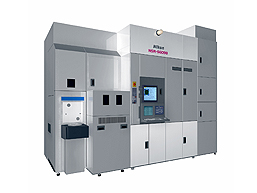Breaking the 1.0 Barrier to Achieve the World's First Ultra-High N.A. 1.07 with High Throughput via Tandem Stage Announcing the Sale of Nikon ArF Immersion Scanner NSR-S609B
June 30, 2005

Nikon Corporation (Michio Kariya, President) has achieved the world's first ultra-high N.A. lens of 1.07 through the use of immersion lithography technology. The NSR-S609B is an ArF immersion scanner, which provides high throughput via its tandem stage. Sales of this system will start from the fourth quarter of 2005.
The NSR-S609B will support the production of advanced 55 nm and smaller devices with the world's highest N.A. projection lens, for use with ArF excimer lasers (193 nm wavelength).
Sales Summary
| Product name | Nikon ArF Immersion Scanner NSR-S609B |
|---|---|
| Sales launch term | Fourth Quarter 2005 |
Development Background
VLSI chips, the foundation of the IT revolution, are becoming ever denser and the industry is now moving to the development of devices at the 65 nm node. While Nikon is working to further the development of next-generation lithography tools, at the same time we are also making efforts to extend the life of DUV excimer steppers and support further miniaturization without any major changes to conventional processes. Nikon's new model, the ArF Immersion Scanner NSR-S609B, utilizes immersion lithography in which the space between the projection lens and the wafer is filled with purified water with a refractive index of 1.44. This immersion technology enables the NSR-S609B to break through the N.A. 1.0 barrier to achieve the world's highest N.A. of 1.07, an impossible feat with dry exposure. This system will support the production of advanced 55 nm and smaller devices.
The NSR-S609B, equipped with POLANO, Nikon's polarized illumination function, can achieve a half-generation improvement in resolution to further improve image contrast and turn the world of 50 nm and smaller devices into reality.
The system's newly-developed tandem stage markedly improves alignment accuracy and attains a high throughput that is nearly equivalent to that of conventional dry systems.
Main Performance Features
| Resolution | 55 nm or better |
|---|---|
| N.A. (Numerical aperture) | 1.07 |
| Light source | ArF excimer laser (wavelength: 193 nm) |
| Projection magnification | 1:4 |
| Maximum exposure field | 26 x 33 mm |
| Alignment accuracy | 7 nm or better (M + 3 σ) |
| Throughput (per hour) | 130 or more wafers (300 mm wafers) |
Main Characteristics
- Mass Production Levels with Nikon's Proprietary Immersion Technology
By employing the world's highest N.A. projection lens (N.A. 1.07) and Nikon's original local fill nozzle, this system supports the production of advanced 55 nm and smaller devices.
- Even Higher Resolution with the POLANO Polarized Illumination Function
By equipping this system with the POLANO polarized illumination function, which improves image contrast by 20% without losing exposure power, Nikon has made it possible to achieve a resolution of 50 nm or better.
- High Throughput and High Accuracy with the Newly-Developed Tandem Stage
The newly-developed tandem stage consists of an exposure stage and a calibration stage. Thus, the impact on throughput is minimized because water is supplied continuously during wafer exchange, enabling a high throughput of 130 wafers or more per hour. Furthermore, since calibration is performed each time a wafer is exchanged, alignment accuracy is also improved.
- Further Improvement in Alignment Accuracy
The highly rigid body design of previous models has been carried forward to the S609B. This combined with the tandem stage and other improvements results in an alignment accuracy of 7 nm or better (an improvement of about 40% over previous models).
- The information is current as of the date of publication. It is subject to change without notice.
